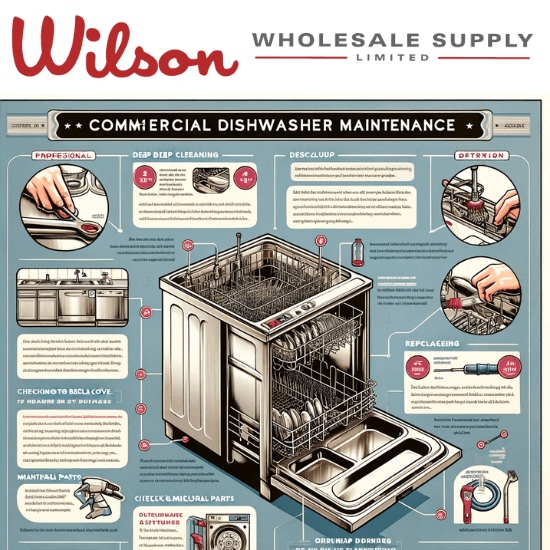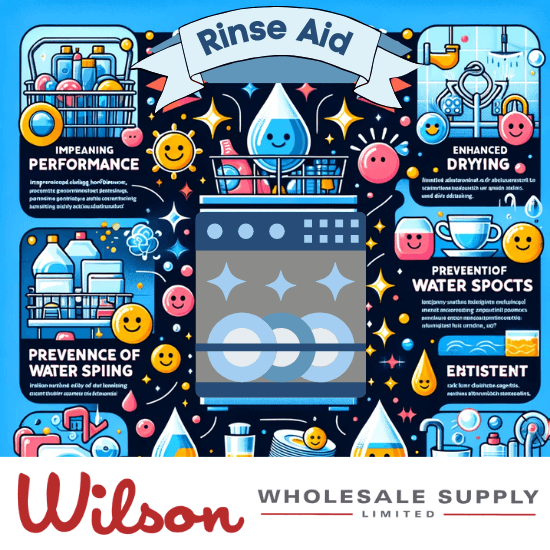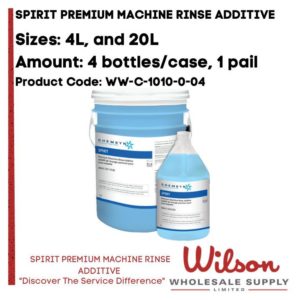How To Clean a Dishwasher Rinse Aid Dispenser
Optimizing Dishwashing Efficiency: A Guide to Maintaining Your Rinse Aid Dispenser
Are you tired of dealing with cloudy glassware and lackluster silverware after each dishwasher cycle? There’s a solution at hand! In this comprehensive guide, we’ll delve into the importance of maintaining your dishwasher rinse aid dispenser for both home and commercial settings, ensuring sparkling-clean dishes every time.
Understanding the Difference: Home vs. Commercial Dishwashers
Before we dive into the maintenance tips, it’s crucial to differentiate between home and commercial dishwashers. Home dishwashers, commonly found in residential kitchens, require manual cleaning and maintenance of the rinse aid dispenser. On the other hand, commercial dishwashers, prevalent in busy food service establishments, often utilize automated chemical dispenser systems. These systems regulate the dosage of cleaning agents, simplifying maintenance tasks for commercial kitchens.
The Role of Rinse Aids in Dishwashing Efficiency
Rinse aids play a pivotal role in dishwashing by effectively rinsing off soapy water and food residues, resulting in spot-free and gleaming dishes. These solutions contain surfactants and softeners that reduce water spotting and aid in drying performance, ensuring impeccable results with every wash.
Maintenance Tips for Home Dishwashers:
- Power Down and Open Up: Start by powering down your dishwasher and disconnecting it from water sources. Open the dishwasher door to access the rinse aid dispenser.
- Cleanse and Purge: Remove the dispenser cap and, if necessary, use a turkey baster to remove any old rinse aid or foreign substances. Cleanse the dispenser tank with water until clear.
- Refill and Replace: Fill the dispenser with a commercial rinse aid solution and securely replace the cap.
- Reconnect and Test: Reconnect your dishwasher to water sources, ensuring no leaks from rubber seals. Run an empty wash cycle with hot water to ensure proper functionality.

Maintenance Tips for Commercial Dishwashers:
Maintaining commercial dishwashers is essential for ensuring smooth operation and optimal cleaning performance. Here are the benefits of following these maintenance tips:
- Efficient Cleaning: Regular monitoring of dishwasher chemical levels ensures that commercial dishwashers consistently deliver clean and sanitized dishes, meeting stringent hygiene standards required in food service establishments.
- Regulated Product Dosages: Automated chemical dispenser systems accurately regulate the dosage of cleaning agents, minimizing waste and ensuring cost-effectiveness in detergent and rinse aid usage. This helps control operational costs for businesses.
- Consistent Results: By maintaining proper chemical levels, commercial dishwashers produce consistent cleaning results with every cycle, reducing the risk of re-washing or re-sanitizing dishes and improving overall efficiency in busy kitchen environments.
- Prevention of Scale Buildup: Occasional descaling prevents the accumulation of mineral deposits and scale in the dishwasher’s internal components, such as heating elements and spray arms, optimizing performance and preventing damage that can result from scale buildup.
- Streamlined Operations: By adhering to a maintenance schedule that focuses on essential tasks such as replacing cleaning agents and occasional descaling, businesses can streamline dishwasher operations, minimizing downtime and maximizing productivity in busy kitchen environments.

How Often to Clean a Home Dishwasher Rinse Aid Dispenser
Maintaining the cleanliness of your home dishwasher rinse aid dispenser is crucial for achieving optimal cleaning results. Here are the benefits and recommended practices:
- Optimal Functionality: Regular cleaning, ideally once a month, ensures that the rinse aid dispenser operates efficiently, distributing the solution effectively during the rinse cycle.
- Prevents Clogging: Cleaning the dispenser regularly helps prevent buildup of residue or debris, reducing the risk of clogs that can impede the flow of rinse aid and compromise cleaning performance.
- Ensures Consistent Results: By keeping the rinse aid dispenser clean, you can maintain consistent results with each dishwasher cycle, ensuring that your dishes emerge spot-free and sparkling every time.
- Extended Lifespan: Proper maintenance prolongs the lifespan of your dishwasher and its components, including the rinse aid dispenser, saving you money on repairs or replacements in the long run.
- Convenience: By adhering to a monthly cleaning schedule and regularly checking the rinse aid level indicator, you can avoid unexpected issues such as running out of rinse aid mid-cycle, ensuring uninterrupted operation of your dishwasher.
Exploring Natural Alternatives for Home Dishwashers
For those inclined towards eco-friendly options, natural rinse agents like vinegar, hydrogen peroxide, or citric acid powder offer viable alternatives. These substances effectively rinse away food particles while being safe for the environment.
- Eco-Friendly Solution: Natural alternatives are environmentally friendly, reducing the use of harsh chemicals that can harm ecosystems.
- Safe for Health: They pose minimal risks to human health, making them suitable for households with children and pets.
- Effective Cleaning: Despite being gentle, natural rinse agents are highly effective at rinsing away food particles and residue, ensuring clean dishes.
- Cost-Effective: They are often more affordable than commercial rinse aids, offering cost savings while delivering excellent cleaning results.
- Versatility: Natural rinse agents have multiple household uses beyond dishwashing, making them practical choices for environmentally-conscious consumers.
- Reduced Chemical Exposure: Opting for natural alternatives reduces exposure to potentially harmful chemicals, promoting a healthier living environment.

For Commercial Dishwashers: It’s important to note that commercial dishwashers must adhere to the guidelines stated in the operator’s manual. While natural alternatives may be suitable for home use, commercial kitchens should follow manufacturer recommendations to maintain warranty coverage and ensure optimal performance.

Embark on a Sparkling Journey with Rinse Aids: Dishwashing’s Dynamic Duo
💧 Unveiling the Magic: Transform water into a seamless cascade for thorough rinsing. Rinse aids guide water to leave dishes spotless and shining.
💧 Casting the Drying Spell: Chemicly accelerate drying, ensuring dishes are cupboard-ready without the need for a towel.
💧 Shielding Against Spots: Act as vigilant guardians against water spots, keeping glassware pristine and spot-free.
💧 Conservation Champions: Teach water the art of efficiency, promoting less waste and energy savings.
💧 Harmonizing Cleanliness: Guarantee a symphony of cleanliness with consistent, spotless results every cycle.
💧 Preserving the Dishwasher Realm: Protect your dishwasher from scale and residue, ensuring its longevity and optimal performance.
In this streamlined tale, rinse aids are not just helpers; they’re indispensable heroes in the dishwashing saga, safeguarding both your dishes and the dishwasher itself.

Summary:
This guide provides a thorough overview on cleaning dishwasher rinse aid dispensers, highlighting the distinction between home and commercial dishwashers, the significance of rinse aids for spotless dishes, and maintenance tips for both settings. It offers practical steps for home dishwasher care, benefits of regular maintenance for commercial machines, and explores natural alternatives for eco-conscious users. The article emphasizes the importance of routine cleaning to ensure optimal dishwashing performance and extend equipment lifespan, ensuring dishes remain sparkling clean.
People Also Ask:
Q: How often should you clean your Home dishwasher rinse aid dispenser?
A: It should be cleaned at least once a month.
Q: What is a dishwasher rinse aid?
A: It is a solution that helps wash off the soapy water and cleanse away food bits from dishes during the dishwasher rinse cycle.
Q: What are rinse aids and sanitizers typically composed of?
A: They are typically composed of surfactants, softeners, antifoaming agents, and other compounds that help reduce water spotting on glasses, plates and silverware and help with drying performance for spot-free dishes.
Q: What are the steps to clean a Home dishwasher rinse aid dispenser?
A: 1, Power Down and Open Up: Start by powering down your dishwasher and disconnecting it from water sources. Open the dishwasher door to access the rinse aid dispenser.
2, Cleanse and Purge: Remove the dispenser cap and, if necessary, use a turkey baster to remove any old rinse aid or foreign substances. Cleanse the dispenser tank with water until clear.
3, Refill and Replace: Fill the dispenser with a commercial rinse aid solution and securely replace the cap.
4, Reconnect and Test: Reconnect your dishwasher to water sources, ensuring no leaks from rubber seals. Run an empty wash cycle with hot water to ensure proper functionality.
Q: How often should you refill your home dishwasher rinse aid dispenser?
A: Most rinse aid solutions should be refilled every two weeks or when the rinse aid level indicator shows that the rinse aid is low.
Q: What should you avoid when choosing a rinse agent?
A: When selecting a rinse agent for dishwashers, avoid products with harsh chemicals, phosphates, and strong fragrances, as these can harm dishes, the dishwasher, and the environment. Also, ensure the agent is compatible with your dishwasher model and opt for high-quality, eco-friendly options to ensure effective cleaning without compromising safety or environmental responsibility.
Q: What is a natural alternative to a rinse agent?
A: White vinegar can be used as a natural rinse agent.
Q: How do you use vinegar as a rinse agent?
A: Fill the rinse aid dispenser with white vinegar and run the dishwasher as usual.
Q: What is a non-toxic alternative to traditional rinse agents?
A: Hydrogen peroxide and citric acid powder are both non-toxic alternatives to traditional rinse agents.
Q: Is a rinse aid dispenser necessary?
A: Yes, rinse aid dispensers are necessary as they help to ensure that dishes and glasses come out clean, spot-free, and shiny. Rinse aid is designed to reduce the surface tension of water and allow it to flow freely over the dishes and glasses, ensuring that any remaining detergent residue is removed. Without a rinse aid dispenser, dishes and glasses may come out with spots, streaks, or cloudiness, which can be unsightly and difficult to remove.
Q: Do you fill rinse aid every wash?
A: No, you do not need to fill rinse aid every wash. Most rinse aid dispensers have a capacity that lasts for several wash cycles. However, the frequency of refilling the dispenser depends on the size of the dispenser, the amount of rinse aid used per wash, and the frequency of dishwasher usage. It is recommended to check the level of rinse aid regularly and refill it when necessary to ensure optimal cleaning performance.
Q: How do you add rinse aid to a dispenser?
A: To add rinse aid to a dispenser, you need to locate the rinse aid dispenser on your dishwasher. The dispenser is usually located near the detergent dispenser and is marked with a symbol that looks like a drop of water. Open the dispenser compartment and fill it with rinse aid, following the manufacturer’s instructions for the recommended amount. Close the dispenser compartment and start the dishwasher. The dispenser will release the rinse aid automatically during the rinse cycle. If you have never used a rinse aid dispenser before, it is recommended to read the dishwasher’s manual for specific instructions on how to fill and use the dispenser.
Finish Rinse Aid
SPIRIT PREMIUM MACHINE RINSE ADDITIVE
Size/Amount: 4×4-Liter, 20-Liter Bucket
Thank You for reading our blog:
How To Clean a Dishwasher Rinse Aid Dispenser
Wilson Wholesale Supply offers FREE Local Deliveries in the Fraser Valley!!!
links
How to Clean and Descale Commercial Dishwashers


0 Comments